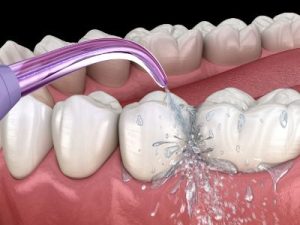Can a Waterpik damage gums? If you rely on your Waterpik for clean gums, or if you’re thinking about starting, you’ll be happy to know that Waterpik flossers don’t damage gums.
In this article, we’ll answer the following questions:
- Does a Waterpik cause bleeding gums?
- How can I use a Waterpik safely?
- Does a Waterpik help with periodontal disease?
We hope that after reading this article, you will have more information on how to properly use a Waterpik water flosser and how to prevent bleeding gums. Also, see our review about the best Waterpiks.
Can a Waterpik damage gums?
The general answer is no. However, if you set the water pressure to a high setting, a Waterpik can hurt your gums. You should always start with a low setting and be cautious when increasing intensity.


Your teeth or gums won’t normally be harmed by a water flosser. In actuality, a water flosser can be less harmful to gums and teeth than traditional floss.
But, there are some caveats. For example, if you use your Waterpik more often than recommended by your dentist, or if you use a high-pressure setting in sensitive areas in the hopes of cleaning your teeth better, you could end up causing some harm.
Nevertheless, if you think that using a Waterpik has harmed or caused bleeding in your gums, you should see your dentist.
You can also read our article on Water flossing vs regular flossing.
Does a Waterpik cause bleeding gums?
No, a Waterpik is not the root cause of bleeding gums. The first time you floss, your gums might bleed, but this should stop within two weeks. However, if it doesn’t stop, see a dentist.
While bleeding may start during flossing, flossing is often not the real reason. In most cases, bleeding when using floss or Waterpiks is caused by a buildup of tartar and plaque that harbors bacteria that cause gum disease.
Typically, bleeding should reduce over time if the underlying problems are properly addressed unless they are especially serious. For instance, research has shown that flossing and brushing together are more efficient than brushing alone in treating minor gum disease or removing plaque.
Water flossers like Waterpiks have also been shown to prevent gum disease and lessen bleeding gums in scientific studies that were done to determine their efficacy.
Read more about the root causes of bleeding gums here.
Also, watch this clip by Teeth Talk Girl to learn more about why Waterpiks can hurt your gums.
How to use a Waterpik safely without damaging your gums
You may choose from a variety of pressure levels on a Waterpik water flosser. To switch between various pressure levels, there should be a mode button. It is advised to start with the lowest pressure setting and gradually raise it as necessary.
To prevent water from spilling over the floor, make sure you’re bending over the sink, then start the water flosser. Make sure your lips are slightly closed and that you are gazing down into the sink. This will prevent splashing when the flosser’s water strikes your teeth while still allowing space for the water to enter the sink.
The water flosser works best when pointed at a 90-degree angle. While treating the top teeth, begin with the rear teeth and work your way forward before starting on the bottom teeth, again beginning at the back. Be careful to pause in the spaces between your teeth.
Read more about using a Waterpik water flosser here.
Conclusion
When you clean or floss your teeth, healthy gums usually don’t bleed. But if you’re like most people, you’ve probably observed that sometimes, when you brush or floss, your gums do bleed. There are several potential causes of bleeding gums, but periodontal disease and gingivitis are the most common.


Your gums get irritated and inflamed due to bacteria, plaque, and tartar along the gumline. Your gums might stop being pink and start pulling away from your teeth.
Your irritated, swollen gums begin to bleed whenever you try to brush or floss away that accumulation.
Gingivitis may develop into periodontitis if it is not treated. The most severe type of periodontal disease, periodontitis, may result in increased gum sensitivity, gum recession, and ultimately tooth loss.
FAQs
Can a Waterpik hurt your gums?
Some people may experience that their gums hurt while using a Waterpik for the first time, especially if their gums are inflamed. Be cautious and start with the lowest water pressure setting.
Can a Waterpik cause gum recession?
No, a Waterpik doesn’t cause gum recession. However, don’t use the water flosser too aggressively, and use the device at the correct angle. Regular use of a Waterpik will improve your gum health.


Is a Waterpik bad for gums?
Using a Waterpik is actually good for your gums. It may be uncomfortable at first, but using a Waterpik daily can possibly prevent gum disease or other related oral health issues.
Does a Waterpik help with periodontal disease?
Yes, a Waterpik can assist in treating periodontal health status. Using a water flosser 1-2 times daily may significantly improve your overall gum health.
Is a Waterpik good for gums?
Using a Waterpik to remove food debris from your teeth may help avoid bleeding and gum disease. Although it doesn’t remove the visible film on your teeth, it may help reduce bacterial growth.
Can a Waterpik damage your teeth or gums?
Your teeth or gums won’t normally be harmed by a water flosser. In fact, a Waterpik can be less harmful to gums and teeth than traditional floss. Just make sure to start with a low-pressure setting.
Aegisdentalnetwork.com: Safety of a water flosser. Consulted 22 August 2022.
Waterpik.com: Using the Water Flosser to Deliver a Dilute of CHX Improves Periodontal Pocket Depth. Consulted 22 August 2022.
Newsinhealth.nih.gov: Don’t toss floss. Consulted 22 August 2022.
Pubmed.ncbi.nlm.nih.gov: The effect of different interdental cleaning devices on gingival bleeding. Consulted 22 August 2022.
Aegisdentalnetwork.com: Safety of a water flosser. Consulted 22 August 2022.
Waterpik.com: Using the Water Flosser to Deliver a Dilute of CHX Improves Periodontal Pocket Depth. Consulted 22 August 2022.
Newsinhealth.nih.gov: Don’t toss floss. Consulted 22 August 2022.
Pubmed.ncbi.nlm.nih.gov: The effect of different interdental cleaning devices on gingival bleeding. Consulted 22 August 2022.




